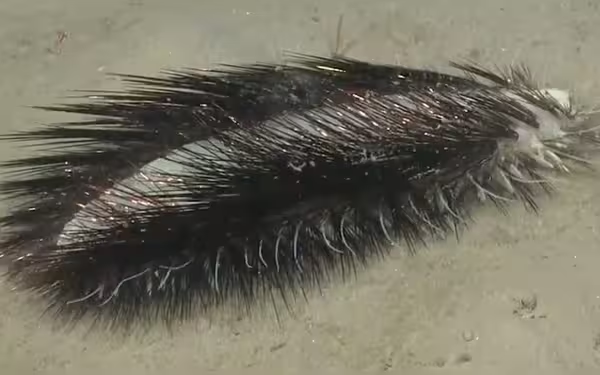Thursday, November 7, 2024 03:39 AM
Scientists Capture Footage of Shimmering Alien-Like Creature in Chilean Ocean
- Scientists film alien-like creature off Chilean coast.
- Polychaete worm exhibits dazzling iridescent bristles.
- Research highlights importance of deep-sea ecosystems.
 Image Credits: mashable_me
Image Credits: mashable_meScientists capture footage of a shimmering, alien-like polychaete worm in the Chilean ocean, revealing the importance of deep-sea ecosystems.
In a remarkable discovery, scientists have recently captured footage of a shimmering, almost alien-like creature in the depths of the ocean off the Chilean coast. This expedition, led by the Schmidt Ocean Institute, is exploring a unique marine environment filled with seeps and vents that release nutrients into the water. The team utilized a 7,055-pound robotic explorer known as ROV SuBastian to document this extraordinary find, a psychedelic marine worm that crawls along the seafloor.
The creature, a type of polychaete, is known for its dazzling bristles, or chaetae, which sparkle in the light. According to the Schmidt Ocean Institute, "Some polychaetes are bioluminescent; this sassy sparkler has protein structures in the bristles, making them iridescent." This fascinating characteristic adds to the visual diversity of polychaetes, which come in over 10,000 described species, each exhibiting a wide range of colors and patterns.
Karen Osborn, the curator of Marine Invertebrates at the Smithsonian's National Museum of Natural History, elaborates on the variety of these creatures, stating, "They come in every imaginable color and pattern, from completely transparent to iridescent to candy-striped." Polychaetes can be found in various shapes and sizes, from tiny microscopic forms to those several feet long. Some are smooth, while others are frilly and elaborate, showcasing the incredible diversity of life beneath the waves.
Beyond their stunning appearance, polychaetes play a vital role in ocean ecosystems. Osborn emphasizes their importance, noting, "Polychaetes are critical members of all ocean food webs." They serve various functions, from being voracious predators to delicate filter feeders and scavengers. These creatures help structure and oxygenate the seafloor, much like earthworms do on land, highlighting their ecological significance.
The ongoing mission, dubbed Chile Margin 2024, focuses on deep-sea seeps where gas from decomposing organisms escapes through the seafloor. This unique environment allows methane-eating microbes to thrive, creating alien ecosystems thousands of feet below the ocean's surface. The researchers are also investigating hydrothermal vents, which are found near tectonic plate boundaries and release hot, chemical-rich fluids into the ocean, often supporting rare marine communities.
As ocean research organizations continue to document and map the deep sea, scientists aim to illuminate the mysteries of this hidden world. Understanding what lies beneath the surface is crucial, especially as deep-sea mineral prospectors prepare to deploy industrial equipment across parts of the seafloor. The potential for discovering new medicines from ocean life is immense. The National Oceanic and Atmospheric Administration notes, "Systematic searches for new drugs have shown that marine invertebrates produce more antibiotic, anti-cancer, and anti-inflammatory substances than any group of terrestrial organisms."
The exploration of the ocean's depths not only reveals stunning creatures like the shimmering polychaete but also underscores the importance of these ecosystems. As we continue to uncover the secrets of the deep sea, we must recognize the potential benefits these discoveries hold for medicine and our understanding of marine life. The ocean is a treasure trove of biodiversity, and protecting it is essential for the health of our planet.













